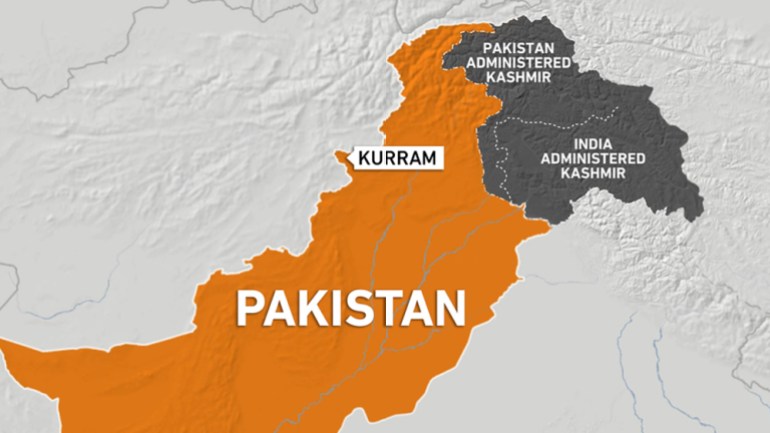
Islamabad, Pakistan – The main highway connecting Pakistan’s Kurram has remained closed for over four weeks as sectarian tensions sparked by land disputes continue to simmer in this tribal district bordering Afghanistan.
A picturesque mountainous region in Khyber Pakhtunkhwa province, Kurram has been plagued by tensions since late July, when a land dispute between Shia and Sunni tribes resulted in at least 46 deaths.
Authorities imposed travel restrictions and boosted security in the wake of the July violence but the measures failed to stop tit-for-tat tribal attacks. In the latest attack, at least 15 people were killed after a convoy came under attack on October 12.
Mehmood Ali Jan, a local peace committee member and part of the jirga, a council of tribal elders, said people have been allowed to travel in only convoys in the past several months. But following the October killings, roads were closed to the public, he said.
Last week, thousands gathered for a “peace march” in Parachinar, the district headquarters, urging the government to enhance security for Kurram’s 800,000 residents, of whom more than 45 percent belong to the Shia minority.
Following the march, the administration has allowed convoy movement four days a week, according to Javedullah Mehsud, Kurram’s deputy commissioner.
“Due to security concerns, we’ve limited travel to convoys with both Shia and Sunni groups four days a week, and we’re hopeful that the situation will improve soon,” he told Al Jazeera.

What is happening in Kurram?
Kurram has a long history of sectarian strife between Shia and Sunni groups. The deadliest period of sectarian violence in recent years was reported between 2007 and 2011, during which more than 2,000 people were killed.
In recent decades, the mountainous region adjacent to Afghanistan’s Khost, Paktia, and Nangarhar provinces has become a hotspot for armed groups, with frequent attacks by Pakistan Taliban, known by the acronym TTP, and ISIL (ISIS) – both staunchly anti-Shia.
Following the July violence, an intertribal ceasefire was signed on August 2, but the region relapsed into renewed violence in late September when at least 25 people were killed.
Tensions further escalated when a convoy was attacked on October 12, resulting in 15 more deaths and the closure of the Thall-Parachinar Road, Kurram’s main highway.
“The [October 12] attack happened in a Shia-dominated area, with Sunni Muslims being targeted. In response, two retaliatory attacks on Shia convoys occurred within a week, but we have managed a temporary ceasefire since October 20,” Ali Jan, the local peace committee member, told Al Jazeera.
He added that while sporadic gunfire still threatens convoys, no further deaths have been reported.
Why is the state unable to control the violence?
Mehsud, the government official, acknowledged that the situation remains volatile, but expressed confidence that peace will eventually return.
“Tribal leaders from both communities are largely cooperating with us, and we’re making concerted efforts to ensure public safety,” he told Al Jazeera.
Mehsud added that “certain elements” aim to keep tensions high but assured that the government is mobilising resources to maintain peace.
“We have security along with the convoys and want Shia and Sunni to move together. Additionally, we have ensured that the supply of medicine, food and other necessities in the district continues without any pause,” he said.
Yet, Mohsin Dawar, a former parliamentarian from North Waziristan in Khyber Pakhtunkhwa province and head of the National Democratic Movement (NDM), questioned the government’s commitment.
“I doubt whether the authorities are genuinely intent on resolving the issue,” Dawar told Al Jazeera, adding that the state’s lax attitude allows the land dispute to take on a sectarian hue, fostering a cycle of revenge.
“Killings beget killings, leading to tribes seeking revenge, and the chain of violence continues. It looks like it is state policy to keep the entire area in chaos,” he said.

Can the violence be contained?
Local authorities say markets in the district have started to open and daily life is slowly resuming, albeit tentatively.
However, residents say the district remains tense, with everyday activities disrupted by road closures and a mobile internet blackout that has lasted three months.
Munir Bangash, a Sunni representative in the jirga, said while the government has tried to maintain peace, “rogue elements” among Shia and Sunni groups continue to fuel the violence.
“It is essential for the state to be actively involved here; otherwise, it could become a free-for-all. Only the state has the capability to mediate effectively,” he said.
Bangash, originally from Parachinar but living in Peshawar since sectarian clashes in 2007, argued that reconciliation will remain challenging until Sunni Muslims, who were displaced in the previous episodes of violence, can return. Nearly 2,000-3,000 Sunni people were displaced from Parachinar and nearby villages. Only a few of them have returned over the years.
“There is a real threat from militancy that affects both communities, but the core issue is the land dispute, which needs urgent resolution,” he said.
Jamil Kazmi, a retired academic based in Kurram, is sceptical about a return to peace, attributing the enduring violence to failures among tribal elders and authorities and a lack of trust among the stakeholders.
“Are the authorities, including the military, as well as the religious leaders from both Sunnis and Shias willing to take ownership of the sectarian problem,” Kazmi, 78, asked.
The situation in Kurram is like a “pressure cooker waiting to explode”, he cautioned.
“The last few days, there has been a bit of calm. But Parachinar feels like a graveyard; it is eerily quiet, and I fear that this tension could explode at any given moment.”





